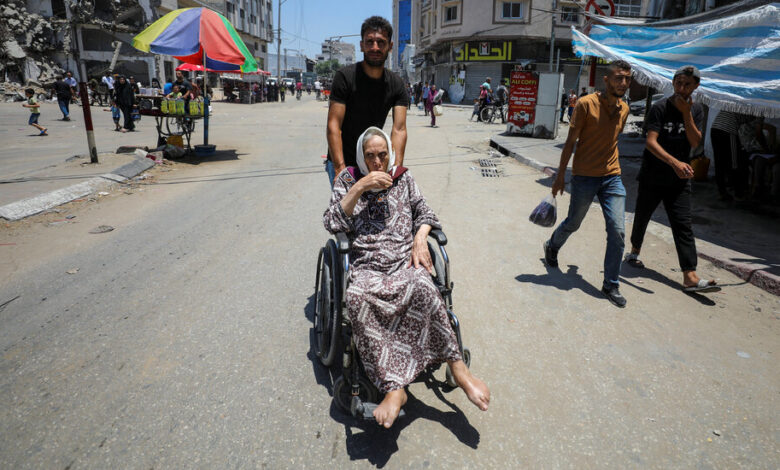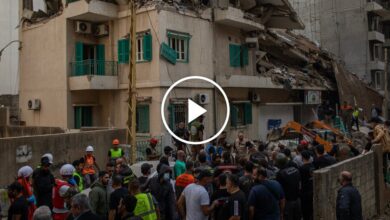Critically Ill Children Allowed to Leave Gaza for First Time Since May

Early in the war against Hamas, as Israeli forces made their way from the north of the Gaza Strip toward the south, a neighborhood in Gaza City called Shajaiye loomed large in the battle. In December, nine soldiers were killed there on what Israel’s military said was one of the deadliest days of the war for its forces.
Later, with Shajaiye ravaged and the Gaza City appearing pacified, the soldiers moved on, eventually taking the fight to Gaza’s southernmost city, Rafah, described as Hamas’s last major stronghold. In turn, Palestinian civilians who had fled the fighting in Gaza City began making their way back.
On Thursday, they were fleeing again.
Israel ordered people in part of eastern Gaza City to evacuate as Palestinian officials and residents reported heavy strikes and multiple casualties. People in the area described a frantic effort to get out as explosions sounded around them. Palestinian officials said the strikes had hit Shajaiye.
Source: Israeli military announcements
By Leanne Abraham and Veronica Penney
“We were hearing explosions from every direction,” said Mohammad al-Bahrawi, 65, who had returned with his family to their home in Shajaiye months ago. He said “a torrent” of people were sent running.
“I couldn’t even believe that this many people were still in Shajaiye,” Mr. al-Bahrawi said.
The Israeli military said that it could not immediately comment on the strikes. Israel’s public broadcaster, Kan, reported that the military was conducting a ground operation to root out Hamas based on intelligence that the armed group had begun to resume control of the neighborhood.
The operation, if confirmed, would be part of a larger pattern of a war in which Israel has struggled to achieve its stated objective: wiping out Hamas, which organized and led the Oct. 7 attacks on Israeli territory that set off the war in Gaza.
Israeli forces have repeatedly found themselves returning to parts of Gaza that they had previously left, especially in the north, as Hamas regroups amid the anarchy of the nine-month war. The fighting has flared even as Prime Minister Benjamin Netanyahu talks of a new, less intense phase.
Within Israel and globally, frustration is growing over what critics say is Mr. Netanyahu’s failure to put forward a plan for how Gaza should be governed should Hamas be defeated.
Daniel Byman, a senior fellow at the Center for Strategic and International Studies, a Washington think tank, said that the key to defeating a counterinsurgency was known by the shorthand “clear, hold, build.”
The Israelis have “thought about Day 1 — kill the bad guys — but have not focused on the next steps,” Mr. Byman said. “That was inexcusable even in October and November. There is less and less excuse now.”
The Gazan health authorities said on Thursday that 15 people had been killed and dozens injured in Shajaiye. Civil Defense, the Palestinian emergency service, said that five homes had been struck in Shajaiye and another neighborhood, and that a search was underway for missing people. The toll could not be independently verified.
Mohammed Qraiqea, a researcher with the Euro-Med Human Rights Monitor advocacy group, who was in Shajaiye, witnessed what he described as artillery shelling, airstrikes and drone fire. H also said that he had seen Israeli tanks on the eastern edge of Gaza City.
“The tanks have advanced in a limited manner, so far, on the outskirts of the neighborhood,” he said Thursday afternoon. By then, he said, most people had evacuated.
Israeli troops invaded northern Gaza in October, taking over territory and pushing south as they took over Hamas strongholds, but they have yet to decisively defeat the armed group. Shajaiye, one of Gaza City’s largest neighborhoods, is home to a battalion that is considered one of the strongest in Hamas’s military wing. It is unclear how big a presence Hamas now has there.
Seth Krummrich, a retired U.S. Army colonel and vice president of Global Guardian, an international security services provider, echoed critics who said Israel was struggling because of its failure to come up with a plan for administering Gaza.
“They have a much bigger problem ahead of them than behind,” Mr. Krummrich said. “The real problem is trying to fix Gaza and make it stable in the future.”
Myra Noveck contributed reporting from Jerusalem.






